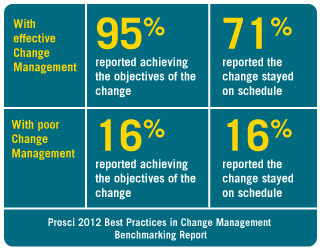The outcome of every change project is based on two distinct components
[raw]
[column size=”1/2″ wpautop=”true”]
The technical component

[/column]
[column size=”1/2″ wpautop=”true”]
The people component

[/column]
[/raw]
it is relatively easy to tell if there is a problem with the technical component. If new machinery or new software doesn’t work then it needs to be fixed. In a worse case scenario you may need to replace all of the technology. Sometimes a change is almost all technical and impacts a very few people.
Its more complicated to identify issues with the people side of change. Does the change have a small or large impact on people’s current roles, work systems, and relationships? How much impact does resistance have on implementation? Does uncertainty about the future create push back in those who must implement, maintain and integrate the change into their daily routines.
Why does the People side of Change matter so much?

Managing the people side of change ensures that those impacted by a change can deliver on the people-dependent portion of a projects ROI.
The data is clear. Studies by McKinsey Data, Prosci, Harvard and others show that initiatives who do a good job of managing the people side of change are six times more likely to meet objectives than those who do not. Event doing a “fair,” job increases the likelihood of meeting objectives by three fold.
For every change project there is a potential for failure. Factor in the percentage that your success depends on people as well as how important the change is to your business to give you as sense of the level of risk. While paying attention to the people side of change will help all projects it is critical in those with high risk. Failing to plan for and address the people side of change can be costly.

Recent Comments